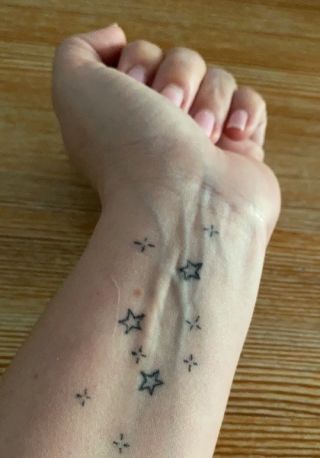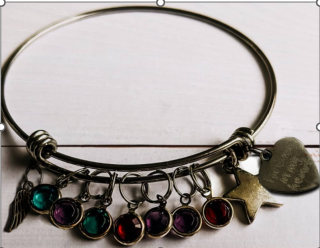Miscarriage
5 Grieving Objects to Commemorate Baby Loss
Objects marking pregnancy loss help with grieving and remembering our babies.
Updated June 19, 2024 Reviewed by Ray Parker
Key points
- Grieving objects can provide solace, even fleetingly, after a loss.
- When it comes to grief following pregnancy loss, it is harder to identify such objects.
- It comes down to the absence of physical traces of life and the disenfranchised nature of this grief.
- Five objects can help real women, including me, to commemorate babies lost in pregnancy.
Wishing to honour the memory of a baby lost in pregnancy seems natural for bereaved parents. Grieving objects could provide solace, even fleetingly. However, when it comes to grief for an unborn child, finding such objects tends to be far from straightforward. This is also true for grief following failed in vitro fertilization (IVF) or involuntary childlessness.
Here's how grieving objects can offer comfort, as well as the complexities of identifying such objects for an unborn child. Then, I present five objects that five real women with lived experience of pregnancy loss, including myself, chose to commemorate our babies.
How Grieving Objects Help
Mourning objects and rituals after someone dies have been present across history and cultures. Their function is, at least partly, to bridge the physical absence of a loved one and their strong emotional presence. Indeed, grieving objects can solidify our loss and help us express and process grief. They also mark an internal relationship with an entity present in our minds but not visible to the rest of the world. They help us maintain a continuous bond with our loved ones in eternity.
Donald Winnicott’s concept of transitional objects (Winnicott, 1953/1975) is pertinent to grief. Winnicott, a pediatrician and psychoanalyst, described how young children often found comfort in soft toys and other materials during separation from their primary caregiver, typically the mother. Such highly invested objects manifest the child’s attachment to their mother. Developmentally, transitional objects also help young children acquire the internal capacity to hold on to their mother while she is not physically there.
In grief, transitional objects can symbolically help us stay connected with the person lost (Wakenshaw, 2020). Indeed, following my grandmother’s death, I would wear her golden cross around my neck for years to come. This cross helped me feel her presence close to me. Goldstein and his research colleagues (2020) found that 98.6% of mothers whose babies died suddenly would visit transitional objects of grief more frequently than once a week. Such objects included baby clothes, stuffed animals, photos, and hand and footprints.
The Challenges of Identifying Grieving Objects for a Child Never Born
The pronounced absence of physical traces of a living existence marks the grief of an unborn child. This is often coupled with the absence of keepsakes. There are no pieces of clothing to smell, photos to frame, or footprints made of clay to stare at. Even if they were, could we label such objects as transitional? After all, what is a bereaved parent trying to hold on to after their baby is lost in pregnancy?
In our world, the personhood of a fetus is conditional to the baby being born alive. This is largely true despite progressive steps being made, such as a pregnancy loss certificate being issued in certain countries, like the UK. The loss of a child never born is a prime example of ambiguous loss, which is a loss not clearly defined (Boss, 2000). The disenfranchised nature of this grief response entails grief not socially acknowledged or distinctly mapped out (Doka, 1989). Thus, bereaved parents of an unborn child may feel less entitled to resort to objects to solidify their experience of grief.
Further, the scarcity of widely shared practices to commemorate such a loss requires bereaved parents to come up with their own unique grieving objects. Researchers Corina Sas and Alina Coman (2016) concluded that personal grieving objects are beneficial but challenging to design. Coming up with one’s symbolic objects can feel like a great demand amid grief. This challenge can be exacerbated by the absence of keepsakes and the guilt or shame that disenfranchised grief imposes.
However, bereaved parents’ attachment to their unborn child can form strong even before the child’s conception. Bereaved parents may feel the need to hold on to their unborn child’s memory and lost future. A physical object could help them foster a continuous bond with their unborn child. Therefore, I have enlisted five unique objects that real women have found to commemorate babies lost in pregnancy.
5 Objects to Help You to Stay Connected With Your Baby

A tattoo: More of a mark than an actual object, Marie Donn’s tattoo brought the lost babies that were “inside” her “body and heart” into the “outside” world and her skin. Marie was looking for her babies “in the stars, sunrises, and sunsets,” and her tattoo is a pattern of ten stars. Three larger stars were drawn for the pregnancies Marie “brought home” and seven smaller ones for those that did not fully reach the end. Marie’s tattoo on her arm with scars made from cannulas and medications during her fertility journey also honours her body. Flesh and spirit combined.

A piece of jewelry: Nicole Narracott felt that she “had nothing to show for the fact that for the briefest time,” she was a “mummy.” Nicole got herself a bracelet with seven birthstones. Each gemstone represents the month when she lost each of her babies during pregnancy. Her bracelet represented tangible proof that her babies’ short lives were not a figment of imagination. Nicole used this bracelet as the cover of her book, The Seven Birthstones, where she candidly narrates her fertility journey.

A family tree: Fiona Murray added her nine lost pregnancies to her online genealogical family tree. Online services have now made it possible to connect with our family and ancestors through the visual representation of a family tree. Fiona has added nine black-and-white silhouettes for her unborn children alongside a photo of her living child. In her tree, Fiona can “hook” or “unhook” these nine silhouettes, so she does not always have to be reminded of her losses in an “in-your-face,” inescapable manner. However, Fiona knows that her nine unborn children have their place in this tree.

A piece of art: After losing two babies through miscarriage, Kat Jackman, illustrator, created a personal illustration to honour her babies in her special way. Her Memory Jar illustration, created with watercolor and ink, depicts two stars above the clouds, representing Kat’s babies. Two swallows are also flying, representing everlasting love, hope, and soul. The sea is a symbol of her grief, and many of Kat’s favourite things are found in her memory jar, standing for the hopes and dreams for her babies’ futures. Although not everyone has Kat’s artistic talent, commissioning a piece of artwork is a possibility for bereaved parents.

A personalised candle holder. This is what I chose for remembering my five babies lost in pregnancies, an experience that I discussed in a previous post. I am fond of the message on the holder: “There is no footprint so small, it doesn’t leave an imprint on this world.” All five losses happened early in pregnancy, and they have candidly stayed as “five little seeds” in my mind. Ephemerally, these seeds held the unfulfilled promise of flourishing into new lives. Each time I burn a candle, I commemorate their short lives’ fleeting flames.
References
Boss, P. (1999). Ambiguous Loss: Learning to Live with Unresolved Grief. Cambridge, MA: Harvard University Press.
Doka, K. J. (Ed.) (1989). Disenfranchised Grief: Recognizing Hidden Sorrow. Lexington, MA: Lexington Books.
Goldstein, R. D., Petty, C. R., Morris, S. E., Human, M., Odendaal, H., Elliott, A. J., Tobacco, D., Angal, J., Brink, L., & Prigerson, H. G. (2020). Transitional objects of grief. Comprehensive Psychiatry. 11 (98), 152161.
Sas, C., & Coman, A. (2016). Designing personal grief rituals: An analysis of symbolic objects and actions. Death Studies, 40 (9), 558–569.
Wakenshaw, C. (2020). The use of Winnicott’s concept of transitional objects in bereavement practice. Bereavement Care, 39 (3), 119-123.
Winnicott, Donald. (1975). Transitional objects and transitional phenomena. In: Through Paediatrics to Psycho-analysis (p. 229-242). London: Hogarth Press. (Original work published 1953)




